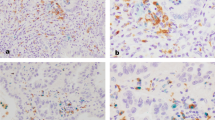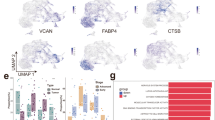Abstract
Lung cancer is one of the most commonly reported cancers, and is known to be associated with a poor prognosis. The function of tumour-associated macrophages (TAMs) in lung cancer patients is multifaceted and the literature shows conflicting roles. (I) To analyze the Th1 and Th2 cytokine levels that contribute to the differentiation of M1 and M2 macrophage populations in the serum of patients with NSCLC versus non-cancer controls; and (II) To characterize the M1 and M2 macrophage populations within TAMs in different subtypes of NSCLC compared to non-tumour tissue. The Th1 and Th2 cytokine levels were analyzed in serum using the Bio-Plex assay. In addition, TAMs subsets from non-tumour and tumour tissues were analyzed using immunohistochemistry (IHC). The level of IL-1β, IL-4, IL-6 and IL-8 was found to be increased in the serum of patients with large cell carcinoma but not in other NSCLC subtypes compared to non-cancer controls. In addition, the expression of CD68 and M2 marker CD163 was found to be increased (P ≤ 0.0001) in all NSCLC subtypes compared to non-tumour tissues. In contrast, the expression of iNOS (M1 marker) was decreased in the tumour tissue of patients with adenocarcinoma (P ≤ 0.01) and squamous carcinoma (P ≤ 0.05) but not in large cell carcinoma compared to non-tumour tissue. The results of this study indicate that NSCLC might have the ability to alter phenotype within the lung tumour areas in the local environment (TAMs) but not in the bloodstream in the systemic environment (serum) except for large cell carcinoma.






Similar content being viewed by others
References
Shih J-Y, Yuan A, Chen JJ-W, Yang P-C (2006) Tumor-associated macrophage: its role in cancer invasion and metastasis. J Cancer Mol 2(3):101–106
Lewis CE, Pollard JW (2006) Distinct role of macrophages in different tumor microenvironments. Cancer Res 66(2):605–612. doi:10.1158/0008-5472.CAN-05-4005
Mantovani A, Sozzani S, Locati M, Allavena P, Sica A (2002) Macrophage polarization: tumor-associated macrophages as a paradigm for polarized M2 mononuclear phagocytes. Trends Immunol 23(11):549–555
Dirkx AE, Oude Egbrink MG, Wagstaff J, Griffioen AW (2006) Monocyte/macrophage infiltration in tumors: modulators of angiogenesis. J Leukoc Biol 80(6):1183–1196, 10.1189/jlb.0905495
Lamagna C, Aurrand-Lions M, Imhof BA (2006) Dual role of macrophages in tumor growth and angiogenesis. J Leukoc Biol 80(4):705–713. doi:10.1189/jlb.1105656
Quatromoni JG, Eruslanov E (2012) Tumor-associated macrophages: function, phenotype, and link to prognosis in human lung cancer. Am J Transl Res 4(4):376–389
Mantovani A, Sica A, Sozzani S, Allavena P, Vecchi A, Locati M (2004) The chemokine system in diverse forms of macrophage activation and polarization. Trends Immunol 25(12):677–686
Lopez-Gonzalez JS, Avila-Moreno F, Prado-Garcia H, Aguilar-Cazares D, Mandoki JJ, Meneses-Flores M (2007) Lung carcinomas decrease the number of monocytes/macrophages (CD14+ cells) that produce TNF-[alpha]. Clin Immunol 122(3):323–329
Ohri CM, Shikotra A, Green RH, Waller DA, Bradding P (2009) Macrophages within NSCLC tumour islets are predominantly of a cytotoxic M1 phenotype associated with extended survival. Eur Respir J 33(1):118–126. doi:10.1183/09031936.00065708
Redente EF, Dwyer-Nield LD, Merrick DT, Raina K, Agarwal R, Pao W, Rice PL, Shroyer KR, Malkinson AM (2010) Tumor progression stage and anatomical site regulate tumor-associated macrophage and bone marrow-derived monocyte polarization. Am J Pathol 176(6):2972–2985. doi:10.2353/ajpath.2010.090879
Zea AH, Rodriguez PC, Atkins MB, Hernandez C, Signoretti S, Zabaleta J, McDermott D, Quiceno D, Youmans A, O’Neill A, Mier J, Ochoa AC (2005) Arginase-producing myeloid suppressor cells in renal cell carcinoma patients: a mechanism of tumor evasion. Cancer Res 65(8):3044–3048
Chang CI, Liao JC, Kuo L (2001) Macrophage arginase promotes tumor cell growth and suppresses nitric oxide-mediated tumor cytotoxicity. Cancer Res 61(3):1100–1106
Biswas SK, Sica A, Lewis CE (2008) Plasticity of macrophage function during tumor progression: regulation by distinct molecular mechanisms. J Immunol 180(4):2011–2017
Gorrin-Rivas MJ, Arii S, Mori A, Takeda Y, Mizumoto M, Furutani M, Imamura M (2000) Implications of human macrophage metalloelastase and vascular endothelial growth factor gene expression in angiogenesis of hepatocellular carcinoma. Ann Surg 231(1):67–73
Edin S, Wikberg ML, Dahlin AM, Rutegard J, Oberg A, Oldenborg PA, Palmqvist R (2012) The distribution of macrophages with a M1 or M2 phenotype in relation to prognosis and the molecular characteristics of colorectal cancer. PLoS One 7(10), e47045. doi:10.1371/journal.pone.0047045
Edin S, Wikberg ML, Oldenborg PA, Palmqvist R (2013) Macrophages: good guys in colorectal cancer. OncoImmunology 2(2), e23038. doi:10.4161/onci.23038
Sica A, Mantovani A (2012) Macrophage plasticity and polarization: in vivo veritas. J Clin Invest 122(3):787–795. doi:10.1172/jci59643
UyBico SJ, Wu CC, Suh RD, Le NH, Brown K, Krishnam MS (2010) Lung cancer staging essentials: the new TNM staging system and potential imaging pitfalls. Radiographics 30(5):1163–1181. doi:10.1148/rg.305095166
Welsh TJ, Green RH, Richardson D, Waller DA, O’Byrne KJ, Bradding P (2005) Macrophage and mast-cell invasion of tumor cell islets confers a marked survival advantage in non-small-cell lung cancer. J Clin Oncol Off J Am Soc Clin Oncol 23(35):8959–8967. doi:10.1200/jco.2005.01.4910
Wang R, Zhang J, Chen S, Lu M, Luo X, Yao S, Liu S, Qin Y, Chen H (2011) Tumor-associated macrophages provide a suitable microenvironment for non-small lung cancer invasion and progression. Lung Cancer (Amsterdam, Netherlands) 74(2):188–196. doi:10.1016/j.lungcan.2011.04.009
Takanami I, Takeuchi K, Kodaira S (1999) Tumor-associated macrophage infiltration in pulmonary adenocarcinoma: association with angiogenesis and poor prognosis. Oncology 57(2):138–142
Ohtaki Y, Ishii G, Nagai K, Ashimine S, Kuwata T, Hishida T, Nishimura M, Yoshida J, Takeyoshi I, Ochiai A (2010) Stromal macrophage expressing CD204 is associated with tumor aggressiveness in lung adenocarcinoma. J Thorac Oncol Off Publ Int Assoc Study Lung Cancer 5(10):1507–1515. doi:10.1097/JTO.0b013e3181eba692
Zeni E, Mazzetti L, Miotto D, Lo Cascio N, Maestrelli P, Querzoli P, Pedriali M, De Rosa E, Fabbri LM, Mapp CE, Boschetto P (2007) Macrophage expression of interleukin-10 is a prognostic factor in nonsmall cell lung cancer. Eur Respir J 30(4):627–632. doi:10.1183/09031936.00129306
Ohri CM, Shikotra A, Green RH, Waller DA, Bradding P (2011) The tissue microlocalisation and cellular expression of CD163, VEGF, HLA-DR, iNOS, and MRP 8/14 is correlated to clinical outcome in NSCLC. PLoS One 6(7), e21874. doi:10.1371/journal.pone.0021874
Bingle L, Brown N, Lewis C (2002) The role of tumour‐associated macrophages in tumour progression: implications for new anticancer therapies. J Pathol 196(3):254–265
Toomey D, Smyth G, Condron C, Kelly J, Byrne AM, Kay E, Conroy RM, Broe P, Bouchier-Hayes D (2003) Infiltrating immune cells, but not tumour cells, express FasL in non-small cell lung cancer: No association with prognosis identified in 3-year follow-up. Int J Cancer J Int Cancer 103(3):408–412. doi:10.1002/ijc.10836
Tataroglu C, Kargi A, Ozkal S, Esrefoglu N, Akkoclu A (2004) Association of macrophages, mast cells and eosinophil leukocytes with angiogenesis and tumor stage in non-small cell lung carcinomas (NSCLC). Lung Cancer (Amsterdam, Netherlands) 43(1):47–54
Ma J, Liu L, Che G, Yu N, Dai F, You Z (2010) The M1 form of tumor-associated macrophages in non-small cell lung cancer is positively associated with survival time. BMC Cancer 10:112. doi:10.1186/1471-2407-10-112
Biswas SK, Gangi L, Paul S, Schioppa T, Saccani A, Sironi M, Bottazzi B, Doni A, Vincenzo B, Pasqualini F, Vago L, Nebuloni M, Mantovani A, Sica A (2006) A distinct and unique transcriptional program expressed by tumor-associated macrophages (defective NF-kappaB and enhanced IRF-3/STAT1 activation). Blood 107(5):2112–2122. doi:10.1182/blood-2005-01-0428
Dinapoli MR, Calderon CL, Lopez DM (1996) The altered tumoricidal capacity of macrophages isolated from tumor-bearing mice is related to reduce expression of the inducible nitric oxide synthase gene. J Exp Med 183(4):1323–1329
Scagliotti GV, Parikh P, von Pawel J, Biesma B, Vansteenkiste J, Manegold C, Serwatowski P, Gatzemeier U, Digumarti R, Zukin M, Lee JS, Mellemgaard A, Park K, Patil S, Rolski J, Goksel T, de Marinis F, Simms L, Sugarman KP, Gandara D (2008) Phase III study comparing cisplatin plus gemcitabine with cisplatin plus pemetrexed in chemotherapy-naive patients with advanced-stage non-small-cell lung cancer. J Clin Oncol Off J Am Soc Clin Oncol 26(21):3543–3551. doi:10.1200/jco.2007.15.0375
Zhang B, Yao G, Zhang Y, Gao J, Yang B, Rao Z, Gao J (2011) M2-polarized tumor-associated macrophages are associated with poor prognoses resulting from accelerated lymphangiogenesis in lung adenocarcinoma. Clinics 66(11):1879–1886. doi:10.1590/S1807-59322011001100006
Chung FT, Lee KY, Wang CW, Heh CC, Chan YF, Chen HW, Kuo CH, Feng PH, Lin TY, Wang CH, Chou CL, Chen HC, Lin SM, Kuo HP (2012) Tumor-associated macrophages correlate with response to epidermal growth factor receptor-tyrosine kinase inhibitors in advanced non-small cell lung cancer. Int J Cancer J Int Cancer 131(3):E227–E235. doi:10.1002/ijc.27403
Belardelli F, Ferrantini M (2002) Cytokines as a link between innate and adaptive antitumor immunity. Trends Immunol 23(4):201–208
Matanic D, Beg-Zec Z, Stojanovic D, Matakoric N, Flego V, Milevoj-Ribic F (2003) Cytokines in patients with lung cancer. Scand J Immunol 57(2):173–178
Romagnani S (1995) Biology of human TH1 and TH2 cells. J Clin Immunol 15(3):121–129
Romagnani S (1996) Th1 and Th2 in human diseases. Clin Immunol Immunopathol 80(3 Pt 1):225–235
Gursel G, Gokcora N, Elbeg S, Samurkasoglu B, Ekim N (1995) Tumor necrosis factor-alpha (TNF-alpha) in pleural fluids. Tuber Lung Dis 76(4):370–371
Brooks N, Stojanovska L, Grant P, Apostolopoulos V, McDonald CF, Pouniotis DS (2012) Characterization of blood monocyte phenotype in patients with endometrial cancer. Int J Gynecol Cancer 22(9):1500–1508. doi:10.1097/IGC.0b013e3182249273
Takahashi H, Ogata H, Nishigaki R, Broide DH, Karin M (2010) Tobacco smoke promotes lung tumorigenesis by triggering IKKbeta- and JNK1-dependent inflammation. Cancer Cell 17(1):89–97. doi:10.1016/j.ccr.2009.12.008
Yi H, Cho HJ, Cho SM, Jo K, Park JA, Kim NH, Amidon GL, Kim JS, Shin HC (2012) Blockade of interleukin-6 receptor suppresses the proliferation of H460 lung cancer stem cells. Int J Oncol 41(1):310–316. doi:10.3892/ijo.2012.1447
De Vita F, Orditura M, Auriemma A, Infusino S, Roscigno A, Catalano G (1998) Serum levels of interleukin-6 as a prognostic factor in advanced non-small cell lung cancer. Oncol Rep 5(3):649–652
Crohns M, Saarelainen S, Laine S, Poussa T, Alho H, Kellokumpu-Lehtinen P (2010) Cytokines in bronchoalveolar lavage fluid and serum of lung cancer patients during radiotherapy—association of interleukin-8 and VEGF with survival. Cytokine 50(1):30–36. doi:10.1016/j.cyto.2009.11.017
Juarez E, Nunez C, Sada E, Ellner JJ, Schwander SK, Torres M (2010) Differential expression of toll-like receptors on human alveolar macrophages and autologous peripheral monocytes. Respir Res 11:2
Waugh DJ, Wilson C (2008) The interleukin-8 pathway in cancer. Clin Cancer Res 14(21):6735–6741. doi:10.1158/1078-0432.CCR-07-4843
Apte RN, Dotan S, Elkabets M, White MR, Reich E, Carmi Y, Song X, Dvozkin T, Krelin Y, Voronov E (2006) The involvement of IL-1 in tumorigenesis, tumor invasiveness, metastasis and tumor-host interactions. Cancer Metastasis Rev 25(3):387–408. doi:10.1007/s10555-006-9004-4
Chen JJ, Yao PL, Yuan A, Hong TM, Shun CT, Kuo ML, Lee YC, Yang PC (2003) Up-regulation of tumor interleukin-8 expression by infiltrating macrophages: its correlation with tumor angiogenesis and patient survival in non-small cell lung cancer. Clin Cancer Res 9(2):729–737
Millar HJ, Nemeth JA, McCabe FL, Pikounis B, Wickstrom E (2008) Circulating human interleukin-8 as an indicator of cancer progression in a nude rat orthotopic human non-small cell lung carcinoma model. Cancer Epidemiol Biomarkers Prev 17(8):2180–2187. doi:10.1158/1055-9965.EPI-07-2915
Culig Z (2011) Cytokine disbalance in common human cancers. Biochim Biophys Acta 1813(2):308–314. doi:10.1016/j.bbamcr.2010.12.010
Albulescu R, Codrici E, Popescu ID, Mihai S, Necula LG, Petrescu D, Teodoru M, Tanase CP (2013) Cytokine patterns in brain tumour progression. Mediat Inflamm 2013:7. doi:10.1155/2013/979748
Pellegrini P, Contasta I, Del Beato T, Ciccone F, Berghella AM (2011) Gender-specific cytokine pathways, targets, and biomarkers for the switch from health to adenoma and colorectal cancer. Clin Dev Immunol 819724. doi:10.1155/2011/819724
Schuurs AH, Verheul HA (1990) Effects of gender and sex steroids on the immune response. J Steroid Biochem 35(2):157–172
Acknowledgments
This work was supported by the Institute for Breathing and Sleep project Grant and the School of Medical Sciences, RMIT University Grant Scheme.
Ethical Approval
Human Ethics approval was received from RMIT University Human Research Ethics Committee ASEHAPP 15-13 and the informed consent of all participants was obtained.
Author information
Authors and Affiliations
Corresponding author
Rights and permissions
About this article
Cite this article
Almatroodi, S.A., McDonald, C.F., Darby, I.A. et al. Characterization of M1/M2 Tumour-Associated Macrophages (TAMs) and Th1/Th2 Cytokine Profiles in Patients with NSCLC. Cancer Microenvironment 9, 1–11 (2016). https://doi.org/10.1007/s12307-015-0174-x
Received:
Accepted:
Published:
Issue Date:
DOI: https://doi.org/10.1007/s12307-015-0174-x




